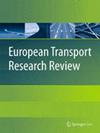MaaS建模:对因素、客户概况、选择和商业模式的回顾
IF 4.2
3区 工程技术
引用次数: 0
摘要
移动即服务(MaaS)系统被认为是一种新兴的解决方案,提供集成的、无缝的、灵活的多模式移动服务,作为私有移动资源的替代方案。预计MaaS将改变用户选择交通方式来完成日常活动的方式,以及服务提供商如何产生利润、合作和竞争。为了成功地部署MaaS以达到预期目标,开发可行且可持续的模型至关重要,这些模型可以捕获客户的不同需求以及服务提供商的不同且经常相互竞争的目标。本文旨在提供一个通用的建模框架,并对MaaS生态系统中所有主要参与者的相关文献进行批判性和描述性分析,并确定和讨论所有被认为相关的因素,重点关注参与者的决策过程及其相关性。这篇综述显示了影响MaaS采用的各种因素和相互作用,以及它们对预测MaaS吸引力的影响。研究还发现,当前的出行行为和多式联运模式并没有充分反映潜在MaaS用户的不同出行需求和选择。基于主体的仿真和离散选择建模的最新进展为解决这一差距提供了潜在的解决方案,未来的研究应该朝着这个方向发展。最后,本文分析了MaaS参与者(包括客户、服务提供商、政府和MaaS经纪人)之间的相互作用,强调了包含MaaS生态系统所有参与者的建模过程的复杂性。因此,建议未来的研究优先探索这些领域。本文章由计算机程序翻译,如有差异,请以英文原文为准。
MaaS modelling: a review of factors, customers’ profiles, choices and business models
Abstract Mobility-as-a-Service (MaaS) system is regarded as one of the emerging solutions to offer integrated, seamless, and flexible multi-modal mobility services as an alternative to privately owned mobility resources. MaaS is expected to change the way users will choose their modes of transport to reach their daily activities, and how service providers will generate profits, cooperate, and compete. To successfully deploy MaaS to reach the intended goals, it is critical to develop feasible and sustainable models that capture the diverse needs of customers as well as the diverse and often competing objectives of service providers. This paper aims to provide a general modelling framework and a critical and descriptive analysis of the relevant literature relating all main actors in the MaaS ecosystem, and identify and discuss all factors that are considered relevant, focusing on the actor’s decision-making processes and their correlations. This review shows the large variety and interaction of factors influencing MaaS adoption and their impact on forecasting MaaS appeal. It is also observed that current travel behaviour and multi-modal transport models are not fully capturing the diverse travel needs and choices of potential MaaS users. Recent advancements in agent-based simulation and discrete choice modelling offer potential solutions to address this gap, and future research should aim in that direction. Finally, the review analyses the interaction between MaaS actors, including customers, service providers, the government, and the MaaS Broker, highlighting the complexity of the modelling process comprising all actors of the MaaS ecosystem. Therefore, it is recommended to prioritise future research in exploring these areas.
求助全文
通过发布文献求助,成功后即可免费获取论文全文。
去求助
来源期刊

European Transport Research Review
Engineering-Mechanical Engineering
CiteScore
9.70
自引率
4.70%
发文量
49
期刊介绍:
European Transport Research Review (ETRR) is a peer-reviewed open access journal publishing original high-quality scholarly research and developments in areas related to transportation science, technologies, policy and practice. Established in 2008 by the European Conference of Transport Research Institutes (ECTRI), the Journal provides researchers and practitioners around the world with an authoritative forum for the dissemination and critical discussion of new ideas and methodologies that originate in, or are of special interest to, the European transport research community. The journal is unique in its field, as it covers all modes of transport and addresses both the engineering and the social science perspective, offering a truly multidisciplinary platform for researchers, practitioners, engineers and policymakers. ETRR is aimed at a readership including researchers, practitioners in the design and operation of transportation systems, and policymakers at the international, national, regional and local levels.
 求助内容:
求助内容: 应助结果提醒方式:
应助结果提醒方式:


